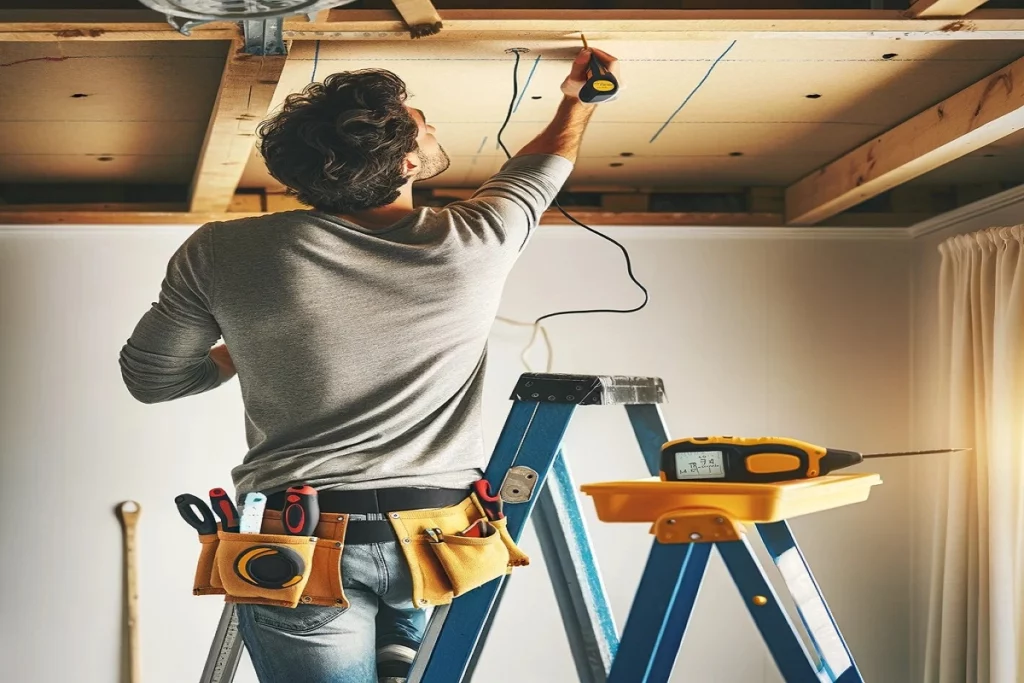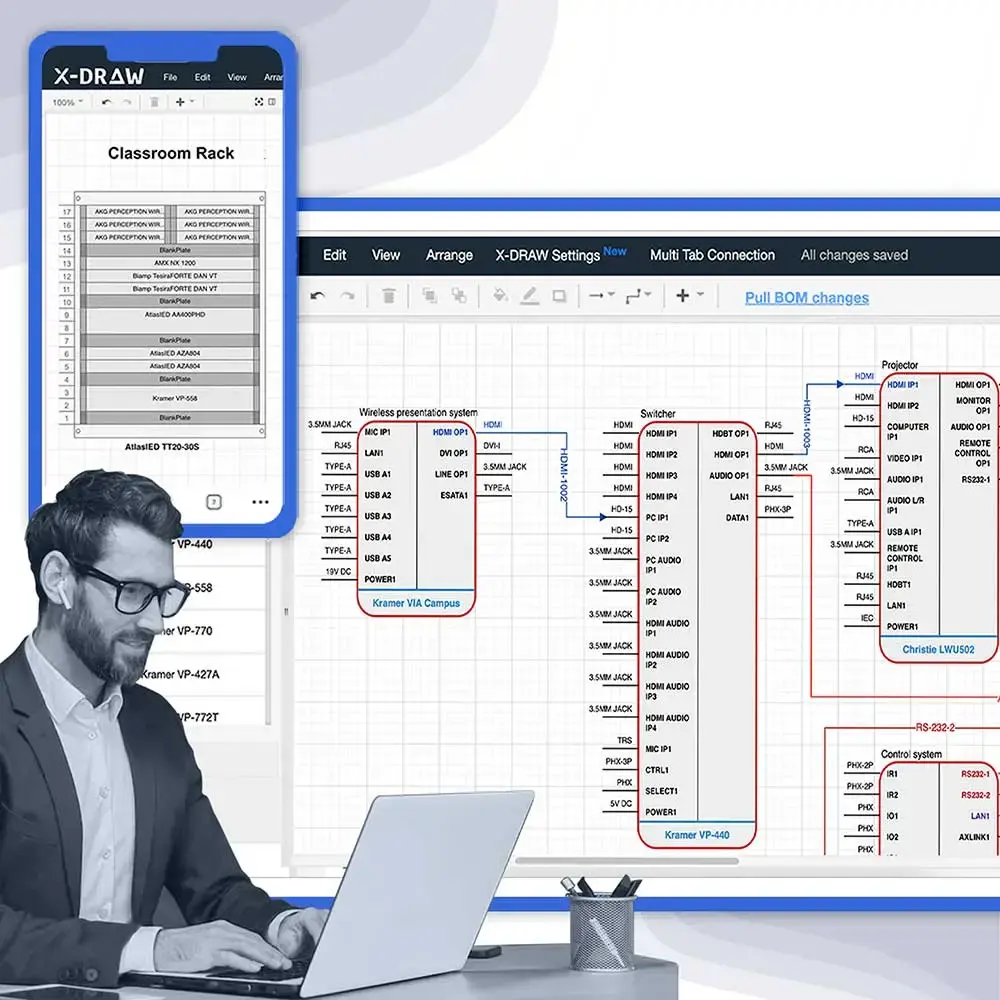How Much Does a Ceiling Speaker Installation Cost?
Are you considering installing a ceiling speaker system in your home or office? You’re in the right place! Wondering about the ceiling speaker installation cost? The answer varies depending on factors like speaker type, number, installation complexity, location, and installer expertise.
Here are some estimated costs:
- Basic in-ceiling speaker installation (1-2 speakers): $200-$500
- Mid-range in-ceiling speaker installation (3-5 speakers): $500-$1,500
- High-end in-ceiling speaker installation (6-10 speakers): $1,500-$3,500
- Custom or complex installations: $3,500-$6,000 or more
But don’t worry, we’ll dive deeper into these costs and explore the various factors that can impact your ceiling speaker installation cost. By the end of this article, you’ll have a better understanding of what to expect and how to plan your audio upgrade project.
The all-in-one solution for your AV needs
Transform your audio-visual experience with XTEN-AV.
No Credit Card required
AV Design Mastery + Winning Proposals = 10x Productivity!
- Automatic Cable Labeling & Styling
- 100+ Free Proposal Templates
- Upload & Create Floor Plans
- 1.5M Products from 5200 Brands
- AI-powered ‘Search Sense'
- Legally Binding Digital Signatures
No Credit Card Required
Key Takeaways
- Ceiling speaker installation costs vary widely depending on several factors involved.
- Multiple factors affect installation costs and complexity of the project overall.
- Ongoing expenses include energy consumption and regular maintenance requirements too.
- DIY installation risks safety and warranty issues if not done correctly.
- Plan ahead carefully to ensure a successful ceiling speaker installation project.
What Factors Affect Ceiling Speaker Installation Cost?
When creating an immersive audio experience, ceiling speakers are an excellent choice. They provide a sleek, unobtrusive way to deliver high-quality sound in various settings, from conference rooms to auditoriums. However, the cost of installing ceiling speakers can vary significantly depending on several factors. Let’s break down these factors to help you better understand what to expect.
Number and Type of Speakers
The number of speakers you need is a significant factor in determining the overall cost of installation. The more speakers you require, the higher the cost. This might seem obvious, but it’s essential to consider the size of your room and the type of audio coverage you need.
For example, a small conference room might require only two or three speakers, while a large auditorium might need a dozen or more. Additionally, the type of speaker you choose can also impact the cost. Basic, entry-level speakers are less expensive than high-end models with advanced features like wireless connectivity or high-fidelity sound.
Room Size and Complexity
The size and complexity of your room play a significant role in determining the installation cost. Larger rooms or those with complex layouts, such as multiple levels or obstructions, require more speakers and labor to ensure even audio coverage.
For instance, a room with a high ceiling or a lot of reflective surfaces might require additional speakers or specialized acoustic treatment to achieve optimal sound quality. Similarly, a room with multiple levels or a complex layout might require more speakers and wiring to ensure that everyone in the room can hear the audio clearly.
Mounting and Installation Requirements
The type of ceiling you have can significantly impact the ceiling speaker’s installation process. Different ceiling types require different mounting and installation techniques, which can affect the cost. For example:
- Drop-tile ceilings are generally the easiest to work with, as they allow for easy access to the space above the ceiling.
- Drywall ceilings are more common, but they require more labor to install speakers, as the drywall must be cut and patched to accommodate the speakers.
- Concrete ceilings are the most challenging, as they require specialized drilling and anchoring equipment to secure the speakers.
Audio System Design and Configuration
The audio system design and configuration also play a crucial role in determining the installation cost. The number of zones, amplifiers, and processing equipment required to support your ceiling speakers can add up quickly.
For example, a simple system with a single zone and a basic amplifier might be relatively inexpensive. However, a more complex system with multiple zones, high-end amplifiers, and advanced processing equipment can be much more costly.
Labor Costs and Location
Finally, the cost of labor varies depending on your location. Urban areas tend to have higher labor costs than rural areas, which can impact the overall installation cost. Additionally, local regulations, permits, and inspections can also add to the cost.
By understanding these factors, you can better plan and budget for your ceiling speaker installation project. Remember, a well-designed and installed audio system can elevate your audio experience and provide a strong return on investment.
What Are The Ongoing Ceiling Speaker Installation Expenses?
You’ve invested in a top-notch ceiling speaker installation, but that’s not the end of the story. Like any technology, ceiling speakers require ongoing maintenance and expenses to ensure they continue to perform at their best. Here are the key ongoing expenses to consider:
- Energy Consumption: Ceiling speakers consume power, which translates to increased utility bills. However, most modern speakers are designed to be energy-efficient, so this expense is relatively minimal.
- Maintenance and Repair: Regular system checks and software updates can help prevent issues, but occasional repairs may still be necessary. Budget for labor costs and replacement parts.
- Content and Licensing Fees: If you’re using your ceiling speakers for background music or public announcements, you may need to pay content licensing fees or royalties.
- System Upgrades: As technology advances, you may want to upgrade your system to take advantage of new features or improve performance. This can involve hardware upgrades, software updates, or system redesign.
- Monitoring and Support: Consider investing in remote monitoring and priority support to ensure your system is always running smoothly and efficiently.
By factoring these ongoing expenses into your budget, you can ensure your ceiling speaker installation continues to deliver exceptional performance and value over time.
How Do You Set A Budget For Ceiling Speakers?
Setting a budget for ceiling speakers can be a daunting task, but don’t worry. We’ve got you covered! Here’s a step-by-step guide to help you determine how much to spend on your ceiling speaker installation.
Step 1: Define Your Goals
Identify the purpose of your ceiling speakers. Are they for background music, public announcements, or full-range audio? This will help you determine the required sound quality and coverage area. Consider the acoustic design and audio system architecture to ensure optimal performance.
Step 2: Assess Your Space
Measure your room’s square footage and ceiling height. This will help you determine the number of speakers needed and the mounting requirements. Take into account the room’s reverberation time and sound absorption to ensure clear and crisp audio.
Step 3: Choose Your Speakers
Research different speaker types, such as in-ceiling, on-ceiling, or pendant speakers. Consider factors like sound quality, power handling, and aesthetics. Look for speakers with high sensitivity and low distortion for optimal performance.
Step 4: Calculate Labor Costs
Factor in labor costs for installation, including cable runs, mounting, and testing. Consider hiring a certified AV installer to ensure a professional installation.
Step 5: Add Upgrades and Extras
Consider upgrades like wireless connectivity, volume controls, or audio processing equipment. You may also want to add microphones, amplifiers, or DSP systems to enhance your audio system.
Budget Breakdown:
- Speakers: 40-60% of total budget
- Labor: 20-30% of total budget
- Upgrades and Extras: 10-20% of total budget
Diy Ceiling Speaker Installation Vs. Hiring A Pro
Are you considering installing ceiling speakers in your home or office? You’re probably weighing the pros and cons of doing it yourself (DIY) versus hiring a professional. In this article, we’ll break down the differences between the two options to help you make an informed decision.
DIY Ceiling Speaker Installation: The Pros and Cons
Pros:
- Cost-effective: DIY installation can save you money on labor costs.
- Flexibility: You can install the speakers at your own pace and schedule.
- Learning experience: You’ll gain hands-on experience with audio visual equipment.
Cons:
- Technical expertise: You’ll need to have a good understanding of audio system design, acoustics, and electrical wiring.
- Safety risks: Improper installation can lead to electrical shock, fire hazards, or damage to your ceiling.
- Warranty and support: You may void the manufacturer’s warranty if you install the speakers incorrectly.
Hiring a Pro: The Pros and Cons
Pros:
- Expertise: Professional installers have the necessary audio visual certifications, such as CEDIA or InfoComm, to ensure a proper installation.
- Safety: They’ll take care of the installation, minimizing the risk of electrical shock or other safety hazards.
- Warranty and support: They’ll provide a warranty for their work and offer ongoing support.
Cons:
- Cost: Hiring a pro will add to your overall expenses.
- Scheduling: You’ll need to schedule the installation around the pro’s availability.
Key Considerations:
- Complexity of the installation: If you have a simple installation with a few speakers, DIY might be a good option. However, if you have a complex system with multiple zones, audio conferencing, or video conferencing capabilities, it’s best to hire a pro.
- Your comfort level with technology: If you’re not comfortable with audio visual equipment or electrical wiring, it’s best to hire a pro.
- Time and patience: If you have the time and patience to learn about audio visual installation and troubleshoot potential issues, DIY might be a good option.
By considering these factors, you’ll be able to make an informed decision about whether to DIY or hire a pro for your ceiling speaker installation.
What Makes A Ceiling Speaker Project More Expensive Than Others?
Are you wondering why some ceiling speaker projects are more expensive than others? Well, let’s break it down. The cost of a ceiling speaker project can vary depending on several factors. Here are some key considerations that can drive up the cost:
1. Complex System Design
A complex audio system design can increase the cost of a ceiling speaker project. This includes factors such as:
- Multiple zones: If you need to create multiple audio zones, each with its own set of speakers and controls, the cost will be higher.
- Audio conferencing: Adding audio conferencing capabilities can require specialized equipment and installation, increasing the cost.
- Video integration: Integrating video conferencing or digital signage with your ceiling speakers can also add to the cost.
It’s always suggested to use an audio visual system design tool to get accurate and precise design. One key benefit of using a tool like XTEN-AV is that you get designs that adhere to industry standards.
2. High-End Speakers and Equipment
Using high-end speakers and audio equipment can significantly increase the cost of a ceiling speaker project. This includes:
- Premium speaker brands: Brands like Bose, JBL, or Shure can be more expensive than budget-friendly options.
- Advanced audio processing: Adding audio processing equipment like DSPs or equalizers can enhance sound quality but increase the cost.
3. Custom Installation Requirements
Custom installation requirements can also drive up the cost of a ceiling speaker project. This includes:
- Custom mounting: If you need to create custom mounts or brackets for your speakers, the cost will be higher.
- Specialized cabling: Using specialized cabling or fiber optic cables can increase the cost of the project.
4. Large or Complex Spaces
Installing ceiling speakers in large or complex spaces can be more expensive due to:
- More speakers required: Larger spaces may require more speakers to achieve adequate coverage, increasing the cost.
- Additional labor: Complex spaces may require more labor hours to complete the installation, adding to the cost.
Cost of Common Ceiling Speaker Installation Add-Ons
Are you considering adding some extra features to your ceiling speaker installation? Here’s a breakdown of the costs associated with some common add-ons:
- Wireless Connectivity
- Wireless speaker systems: $500-$2,000
- Wireless audio transmitters: $200-$1,000
- Wireless audio receivers: $100-$500
- Volume Controls
- Wall-mounted volume controls: $100-$500
- Wireless volume controls: $200-$1,000
- Smartphone app control: $500-$2,000
- Audio Processing Equipment
- Equalizers: $200-$1,000
- Crossovers: $100-$500
- DSPs (Digital Signal Processors): $500-$2,000
- Microphones
- Wired microphones: $50-$200
- Wireless microphones: $100-$500
- Conference microphones: $200-$1,000
- Amplifiers
- Small amplifiers (1-2 channels): $100-$500
- Medium amplifiers (4-6 channels): $500-$2,000
- Large amplifiers (8-12 channels): $2,000-$5,000
- Audio Conferencing Equipment
- Audio conferencing bridges: $500-$2,000
- Audio conferencing software: $100-$500
- Audio conferencing hardware: $200-$1,000
- Video Integration
- Video conferencing cameras: $200-$1,000
- Video conferencing software: $100-$500
- Video conferencing hardware: $500-$2,000
- Lighting Control
- Basic lighting control systems: $500-$2,000
- Advanced lighting control systems: $2,000-$5,000
- Smart lighting control systems: $5,000-$10,000
- Security Systems
- Basic security systems: $500-$2,000
- Advanced security systems: $2,000-$5,000
- Smart security systems: $5,000-$10,000
Tips To Reduce Cost While Installing Ceiling Speakers
By following these tips, you can reduce the cost of installing ceiling speakers.
- Plan ahead: Consider your long-term needs to avoid costly upgrades.
- Choose the right equipment: Select energy-efficient options and consider refurbished or used equipment.
- DIY installation: Consider installing the speakers yourself, but ensure you have the necessary expertise.
- Shop around: Compare prices from different suppliers to find the best deals.
- Consider alternative options: Look into alternative speaker types, such as in-wall or on-wall speakers.
- Negotiate with the installer: Ask your installer if they can offer any discounts or promotions.
AV Design Mastery + Winning Proposals = 10x Productivity!
- Automatic Cable Labeling & Styling
- 100+ Free Proposal Templates
- Upload & Create Floor Plans
- 1.5M Products from 5200 Brands
- AI-powered ‘Search Sense'
- Legally Binding Digital Signatures
No Credit Card Required
Conclusion
And there you have it – a comprehensive guide to ceiling speaker installation! We hope you found this guide informative and helpful in planning your ceiling speaker project. Remember, the key to a successful installation is to plan, choose the right equipment, and consider your long-term needs. By following these tips and considering the factors that affect cost, you can create an immersive audio experience that will elevate your space and leave a lasting impression.
Ready to experience the power of ceiling speakers for yourself? Book a demo with our team today and discover how our expertly designed and installed ceiling speaker systems can transform your space. Plus, as a special offer, get a free trial of our ceiling speaker system design to see the difference for yourself. Don’t miss out on this opportunity to elevate your audio experience – book your demo and free trial now!
Frequently Asked Questions
The main factors that affect ceiling speaker installation costs include:
- Type of speakers (in-ceiling vs. surface-mounted)
- Number of speakers required
- Complexity of the installation (e.g., running new wiring, cutting holes in the ceiling)
- Size of the room
- Labor costs in your local area.
The average cost to install ceiling speakers ranges from $1,000 to $2,000, with a national average of around $1,700. However, the actual cost can vary significantly based on the factors mentioned above.
While it is possible to install ceiling speakers yourself, it’s generally recommended to hire a professional installer, especially if you have limited experience with home audio installations. Professional installers have the necessary skills, tools, and knowledge to ensure a proper and safe installation, which can prevent costly mistakes. They also have access to high-quality speaker products and can provide a warranty on their work.
Once the initial installation is complete, there are minimal ongoing costs associated with ceiling speakers. You may need to occasionally replace the speaker grilles if they become damaged or discolored over time. Additionally, if you have a multi-room audio system, you may need to pay a monthly or annual subscription fee for the software that manages the system. However, the speakers themselves do not require any regular maintenance or replacement, provided they are installed correctly and not subjected to damage.



